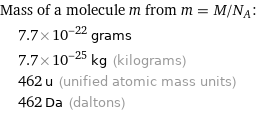Input interpretation
![2-[4-((4-(bis(2-hydroxyethyl)amino)phenyl)(cyano)methyl)-2, 3, 5, 6-tetrafluorophenyl]malonitrile | molar mass](../image_source/7234c8b59ee7c2a888cd7511e1494b8f.png)
2-[4-((4-(bis(2-hydroxyethyl)amino)phenyl)(cyano)methyl)-2, 3, 5, 6-tetrafluorophenyl]malonitrile | molar mass
Result
![Find the molar mass, M, for 2-[4-((4-(bis(2-hydroxyethyl)amino)phenyl)(cyano)methyl)-2, 3, 5, 6-tetrafluorophenyl]malonitrile: M = sum _iN_im_i Plan: • Write the chemical formula and gather atomic masses from the periodic table. • Determine values for N_i and m_i using these items. • Finally, compute the mass. Write the chemical formula: C_22H_18F_4N_4O_3 Use the chemical formula, C_22H_18F_4N_4O_3, to count the number of atoms, N_i, for each element: | N_i O (oxygen) | 3 C (carbon) | 22 N (nitrogen) | 4 F (fluorine) | 4 H (hydrogen) | 18 Look up the atomic mass, m_i, in g·mol^(-1) for each element in the periodic table: | N_i | m_i/g·mol^(-1) O (oxygen) | 3 | 15.999 C (carbon) | 22 | 12.011 N (nitrogen) | 4 | 14.007 F (fluorine) | 4 | 18.998403163 H (hydrogen) | 18 | 1.008 Multiply N_i by m_i to compute the mass for each element. Then sum those values to compute the molar mass, M: Answer: | | | N_i | m_i/g·mol^(-1) | mass/g·mol^(-1) O (oxygen) | 3 | 15.999 | 3 × 15.999 = 47.997 C (carbon) | 22 | 12.011 | 22 × 12.011 = 264.242 N (nitrogen) | 4 | 14.007 | 4 × 14.007 = 56.028 F (fluorine) | 4 | 18.998403163 | 4 × 18.998403163 = 75.993612652 H (hydrogen) | 18 | 1.008 | 18 × 1.008 = 18.144 M = 47.997 g/mol + 264.242 g/mol + 56.028 g/mol + 75.993612652 g/mol + 18.144 g/mol = 462.405 g/mol](../image_source/8a4bb2a633b7a8e5e986d769bb434c11.png)
Find the molar mass, M, for 2-[4-((4-(bis(2-hydroxyethyl)amino)phenyl)(cyano)methyl)-2, 3, 5, 6-tetrafluorophenyl]malonitrile: M = sum _iN_im_i Plan: • Write the chemical formula and gather atomic masses from the periodic table. • Determine values for N_i and m_i using these items. • Finally, compute the mass. Write the chemical formula: C_22H_18F_4N_4O_3 Use the chemical formula, C_22H_18F_4N_4O_3, to count the number of atoms, N_i, for each element: | N_i O (oxygen) | 3 C (carbon) | 22 N (nitrogen) | 4 F (fluorine) | 4 H (hydrogen) | 18 Look up the atomic mass, m_i, in g·mol^(-1) for each element in the periodic table: | N_i | m_i/g·mol^(-1) O (oxygen) | 3 | 15.999 C (carbon) | 22 | 12.011 N (nitrogen) | 4 | 14.007 F (fluorine) | 4 | 18.998403163 H (hydrogen) | 18 | 1.008 Multiply N_i by m_i to compute the mass for each element. Then sum those values to compute the molar mass, M: Answer: | | | N_i | m_i/g·mol^(-1) | mass/g·mol^(-1) O (oxygen) | 3 | 15.999 | 3 × 15.999 = 47.997 C (carbon) | 22 | 12.011 | 22 × 12.011 = 264.242 N (nitrogen) | 4 | 14.007 | 4 × 14.007 = 56.028 F (fluorine) | 4 | 18.998403163 | 4 × 18.998403163 = 75.993612652 H (hydrogen) | 18 | 1.008 | 18 × 1.008 = 18.144 M = 47.997 g/mol + 264.242 g/mol + 56.028 g/mol + 75.993612652 g/mol + 18.144 g/mol = 462.405 g/mol
Unit conversion

0.4624 kg/mol (kilograms per mole)
Comparisons

≈ 0.64 × molar mass of fullerene ( ≈ 721 g/mol )

≈ 2.4 × molar mass of caffeine ( ≈ 194 g/mol )

≈ 7.9 × molar mass of sodium chloride ( ≈ 58 g/mol )
Corresponding quantities

Mass of a molecule m from m = M/N_A: | 7.7×10^-22 grams | 7.7×10^-25 kg (kilograms) | 462 u (unified atomic mass units) | 462 Da (daltons)

Relative molecular mass M_r from M_r = M_u/M: | 462